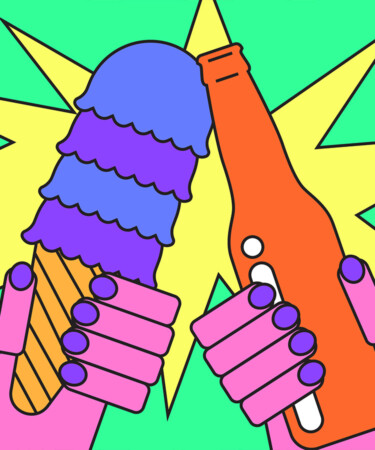This article is part of our Cocktail Chatter series, where we dive into the wild, weird, and wondrous corners of history to share over a cocktail and impress your friends.
As far as the world of booze is concerned, Prohibition was the darkest of times. The passing of the legislation in 1919 made it illegal to produce, sell, or transport “intoxicating liquors,” leaving many to ponder not only what they would do without alcohol to consume, but also what substances people would turn to next in its absence. Turns out, it was nothing illicit that garnered the attention of Americans, but something much sweeter: ice cream.
Despite the fact that ice cream was invented centuries before Prohibition, the cost of producing the delicacy — plus the lack of adequate refrigeration — meant the dessert was almost exclusively enjoyed by the wealthy. However, with advancements in large-scale refrigeration in 1851, by the time World War I finally came to an end, ice cream parlors were much more widely accessible. But for most folks, ice cream still remained an occasional treat. That all changed once the 18th Amendment was signed into law.
Almost immediately thereafter, ice cream shot off in popularity, in part because of more widespread refrigeration, but also because of the social void left behind after bars were forced to shutter their doors. Instead, people bellied up to the bars of local drug stores where they could get a sweet treat from the soda fountain. The ice cream business was so lively that one ice cream manufacturer in Wichita, Kan., went as far as to tell The Wichita Beacon that “Prohibition made the chocolate ice cream soda the national drink.”
By the early 1920s, Americans were “on an ice cream spree” — at least according to the then-secretary of the National Association of Ice Cream Supply Men — with an incredible 325 million gallons of ice cream consumed in 1922 alone. In fact, demand for the frozen dessert was so high that even some American breweries took to producing their own, helping them stay afloat in a time when brewing was banned.
Famously, Anheuser-Busch started making and selling its own ice cream under the campaign “eat a plate of ice cream every day.” Pennsylvania-based Yuengling also took to dishing out ice cream for those hankering for a sweet treat, reportedly producing over 2 million quarts in just a few short years.
The absence of alcohol also led to a number of innovations across the ice cream industry, including the invention of the ice cream bar in 1922 and development of the ice cream truck at the end of the decade. Ice cream was so beloved that it had spawned its own slang, in which the soda used in ice cream floats was “belch water” and malted milk extract was “hops.”
When the 18th Amendment was repealed in 1933, many fanatics feared that the return of alcohol would mean saying goodbye to ice cream. However, as Anne Cooper Funderburg points out in her book, “Chocolate, Strawberry, and Vanilla: A History of American Ice Cream,” sales of the dessert actually increased following the reintroduction of alcoholic beverages.
Though ice cream sales eventually leveled out, the confection remained in public favor, with the United States Navy even shelling out $1 million to construct an ice cream barge to supply soldiers in the Pacific theater with the dessert. Given ice cream’s immense popularity today, it’s highly probable that we would not have the luxurious treat if not for its monumental rise in the absence of “intoxicating liquors.”
